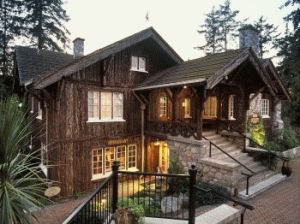
The Latch Inn & Restaurant
Bed & Breakfast
-
Address:
2328 Harbour Road
Sidney, British Columbia
V8L 2P8 - Phone: 1-250-656-4015
- Toll Free: NA
-
Fax:
1-250-656-4016
- Email:
- Website:
-

Distances
- Ferry - Vancouver: 4.6km
- Airport: 6.7km
- Downtown Victoria: 30km
- Downtown Sidney: 2.3km
Miraloma, the private summer residence of Walter C. Nichol (Lieutenant-Governor of British Columbia from 1920 to 1926), has seen many owners over the years who have had the pleasure of hosting elegant garden parties and visiting royalty.
When he began designing this house, the famous Victoria architect Samuel Maclure was told that "it should be something unusual and which would employ, as far as possible, B.C.'s woods." The original house on the property, owned by Mr. Copeman, was also to be embodied in the design.
All this was accomplished with genius. The entire exterior was covered with fir slabs on which the bark was left. The rustic effect was heightened by the porches and balconies built of tree trunks of various sizes fitted into place with skill by the builders, Hunter and Halkett. The whole structure had to be extremely well-built to support the heavy fir slabs. It took ten men to raise the large bark-covered boards which conceal the eaves.
The principle of using B.C. woods was expanded to include the interior as well as exterior. The halls were finished in great panels of native fir: all the other rooms were finished in cottonwood, spruce or beech, a variety of effects achieved by the staining.
Two financial receipts indicate that the contractor's fees may have been a total of $13,145 for the house when it was built in 1926.
More than one artist had a hand in the decorative work. Mr. George Gibson, the Scottish-born craftsman who carved the Chapel of Thistles in Edinburgh, and whom Maclure frequently employed on commissions of this kind, was responsible for the ornamental carvings leading down from the Main Hall to the Dining Room. On the single newel post where the bannister terminates at the foot of the stairs is a grim little bulldog: on the two pillars at the head of the stairs sit a monkey and an owl, all hand-carved of Dogwood. These were carved to represent Strength, Folly and Wisdom.
The decorative panels in the Drawing Room and Dining Room were created by Sheldon Williams, a well-known local artist. The panel in the Dining Room is said to have been commissioned to the honour of the visit of Edward, the Prince of Wales, and his brother George when they were in a state tour of British Columbia in 1927, and depicts various scenes connected with the heritage and heraldry of the Royal Family. The panels in the Drawing Room were done with a "wash effect" and consequently resemble water colours on wood.
Ownership of the house has changed hands a number of times since 1926, though its function has been mainly as a private residence. It was not until the 1940s that the house became known as "The Latch" due, no doubt, to the fact that every door in the house is opened with a latch.
We hope your visit to "The Latch" is an enjoyable experience, and that you will take this opportunity to appreciate and enjoy the beauty and surroundings of the residence designed more than fifty years ago by one of Victoria's leading architects.
Please visit The Latch Inn & Restaurant Website.
The Latch Inn & Restaurant Amenities
To investigate other Sidney accommodations, use these links:
Sidney Hotels, Motels, Resorts, Cabins and Cottages
Sidney Bed and Breakfasts
Sidney Campgrounds and RV Parks